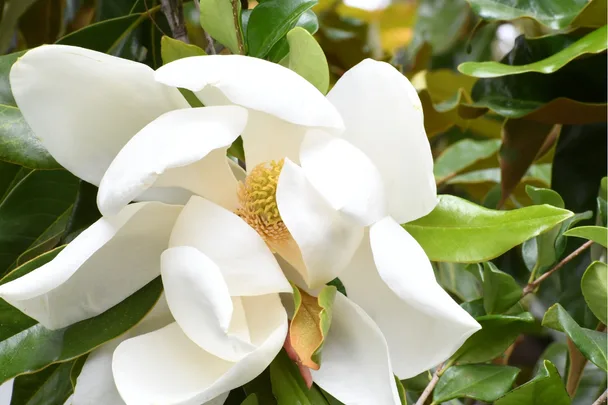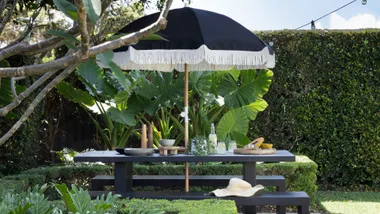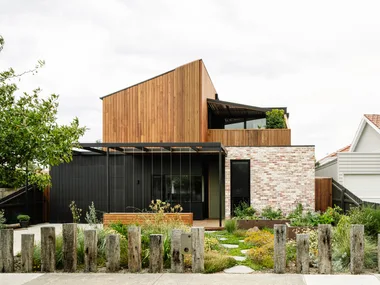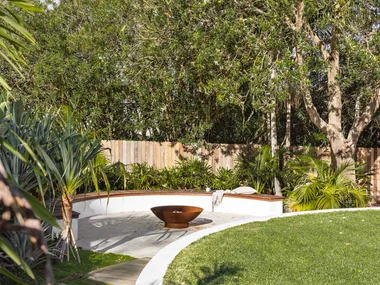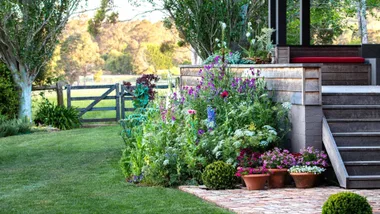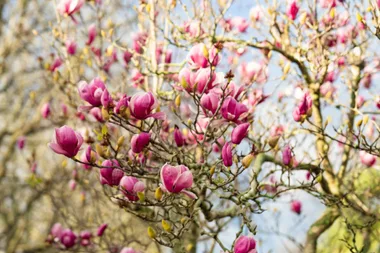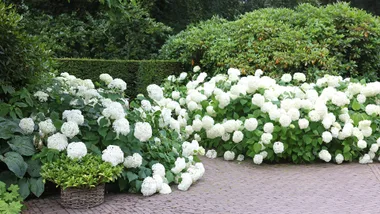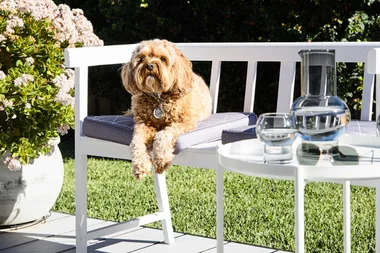A magnolia tree really knows how to put on a show – even if it’s not in flower. Magnolias, with their glossy green leaves, look just as impressive in a manicured garden against a backdrop of buxus hedge, as they do as a statement tree. Growing up to five metres in height, a magnolia tree’s overarching canopy can shield a front garden from harsh sunlight and provide soft, dappled shade. Deciduous trees shed golden leaves in autumn, to reveal a sculptural winter silhouette.
But then the flowers, the flowers. The large blooms resemble fine, bone-china teacups or a ballet dancer’s tutu, gently swaying, as they unfold into arabesque. The creamy petals of white magnolia flowers look so much like freshly baked meringues it’s almost tempting to pluck one from the tree and serve it on a plate just like a delicious pavlova, complete with summer berries. To top it off, magnolia flowers even smell like lemons.
To make a long story short: we think magnolias make a wonderful statement tree in any garden, and given time, can even create a privacy screen. But how exactly do you grow and care for magnolia trees? What growing conditions do they need? How do you go about planting one in your garden? Which is the best variety to grow? We dug deep to bring you the answers to these questions, and more, in our guide to growing magnolias.
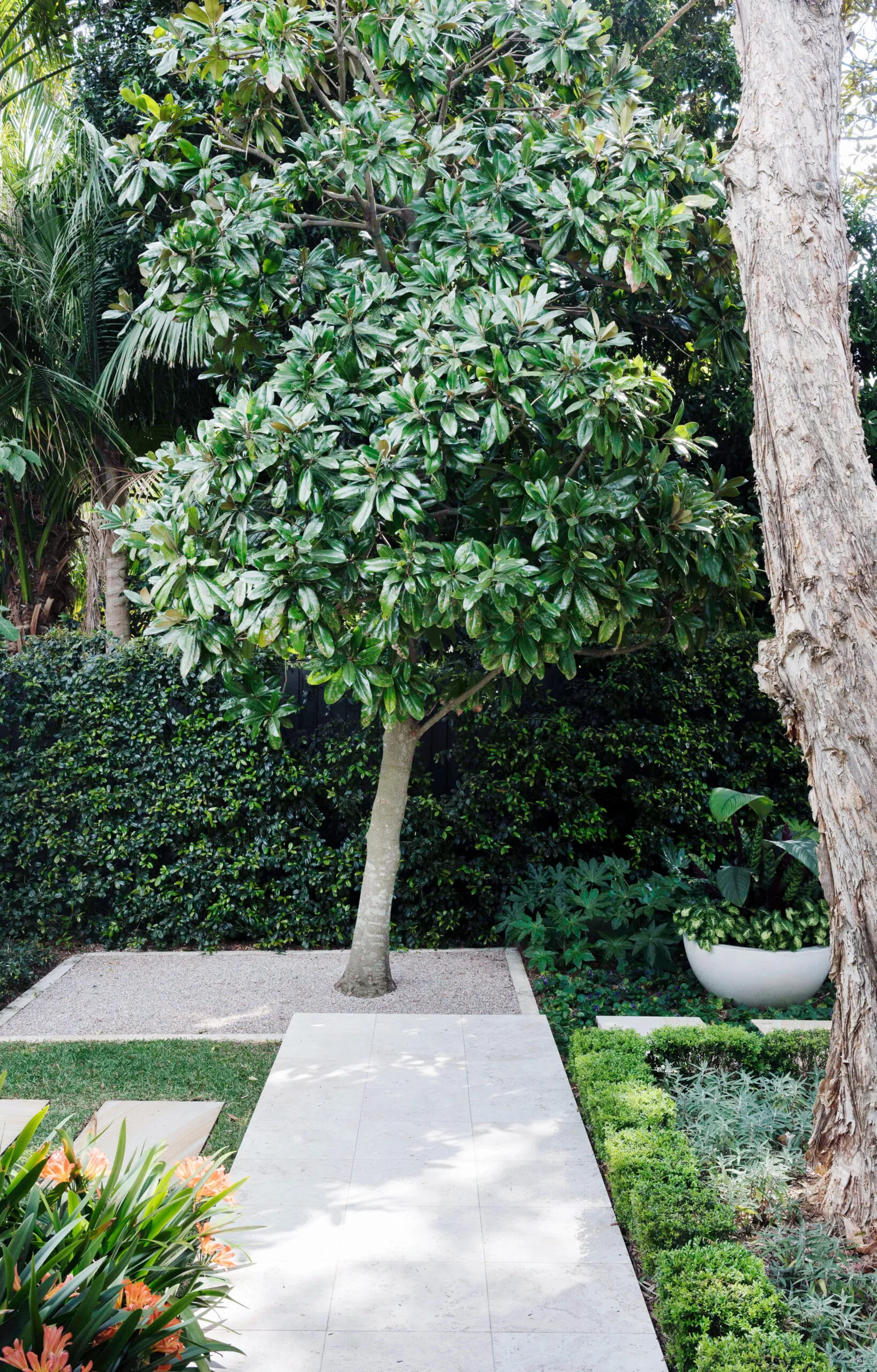
Your speedy magnolia tree guide
A handy guide to magnolia varieties, planting basics and their mature size.
Deciduous vs evergreen magnolias
Broadly speaking, there are two main types of magnolia trees. Evergreen magnolias and deciduous magnolias. Deciduous magnolias drop their leaves during autumn to bare their branches throughout the colder months. Spring is when everything comes alive again and flowers begin to emerge.
Evergreen magnolias, on the other hand, retain their leaves all year round and often flower in spring and summer, or even several times a year.
Deciduous magnolia varieties
- Magnolia ‘vulcan’ pbr ‘Magnolia vulcan’- a deep pink, almost red flower
- Magnolia soulangeana brozzonnii ‘Saucer magnolia’
- Magnolia soulangeana ‘Tulip magnolia’
- Magnolia soulangeana ‘Black Tulip’
- Magnolia x star wars ‘Magnolia Star Wars’
Evergreen magnolia varieties
- Magnolia grandiflora ‘Little Gem’
- Magnolia grandiflora ‘Teddy Bear’
- Magnolia dolsopa x laevifolia ‘Inspiration’
- Magnolia hybrida ‘Magnolia Fairy Cream’
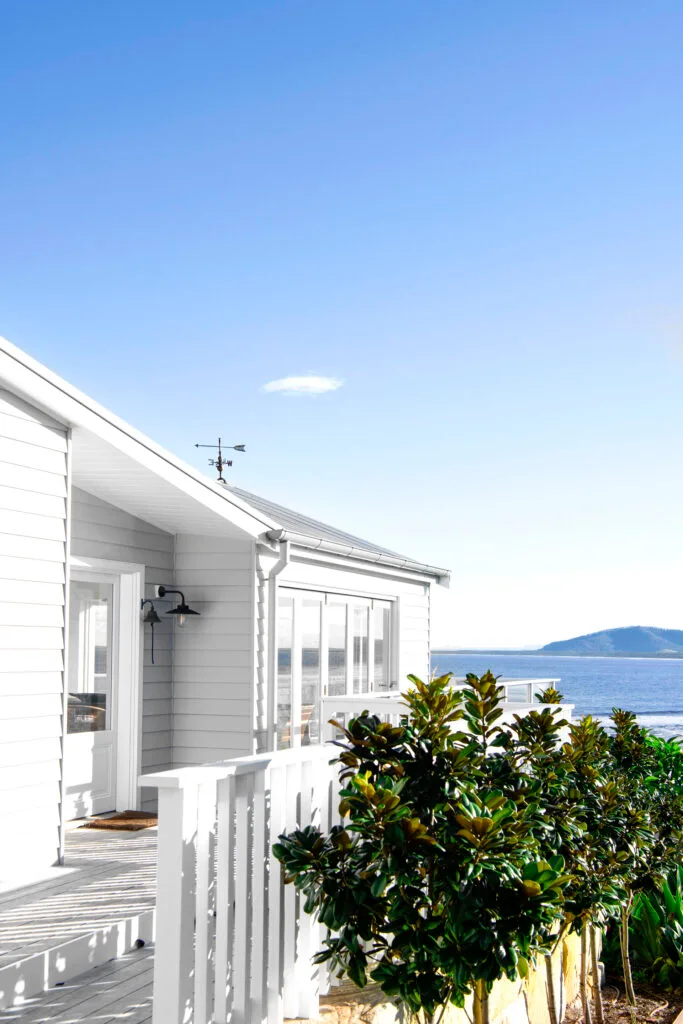
How to plant a magnolia tree
- Nourish the soil: At planting, dig a hole about 1m wide and add compost or rotted manure to the excavated soil before returning it to the hole.
- Dig the hole: To plant the tree, you’ll need to dig a hole that’s double the width of the pot and about the same depth.
- Backfill and water in: Backfill the soil (mixed with compost or manure) and form a raised donut or saucer-shaped depression around the base of the tree to direct water towards the tree’s roots. Water in well and keep the soil damp until the tree is established. This usually takes several weeks.
- Mulch: Apply organic mulch around the base of the tree (keeping it away from the trunk) to prevent soil moisture loss.
Magnolia trees in Australia can grow to be 3-12 meters tall, depending on the variety. Magnolia Vulcan, for example, can reach up to 5 metres in height, while Teddy Bear Magnolia can reach anywhere from 4-5 metres in height.
Some magnolia varieties and their sizes:
How big do magnolia trees grow?
- Magnolia x soulangeana: Can grow up to 8 metres tall and 5 metres wide, and can form a multi-stemmed shrub or a single-trunked small tree
- Magnolia grandiflora ‘Greenback’: Grows to be 5-6 metres tall and 3-4 metres wide
- Magnolia ‘Exmouth’: Can grow to be 12 metres tall and 5 metres wide
- Magnolia Teddy Bear: Can grow to be 4-5 metres tall
- Yulan Magnolia: A small deciduous tree that can grow to be 5 metres tall
- Port Wine Magnolia: An evergreen shrub that grows to be around 3 metres tall
Where is the best place to plant a magnolia tree?
Magnolias prefer full sun over a shady spot. They can tolerate a range of conditions but grow best when sheltered from strong winds. The soil should be moist yet well-drained and slightly acidic. Here’s more detail to help you find the perfect place in your garden for a magnolia plant…
Climate
Deciduous magnolias like a chilly, moist winter followed by a warm, moist summer. They thrive along the Great Dividing Range and in south-east Australia – anywhere rainfall is reasonably generous (or adequate irrigation is available) and where winters are cool enough to induce dormancy. They’re not for the tropics or the steamy sub-tropical coast.
Sun
Full sun is most suitable, but they’ll grow with a little shade and enjoy the shelter of other large shrubs or small trees. Strong winds will damage the flowers and break the brittle branches, so try to plant in protected areas.
Soil
The most important feature of a suitable soil is that it holds moisture but not wetness. Average garden soil will suffice as long as it drains freely. Magnolias grow naturally in soils that are deep and rich in rotted organic matter. Slightly acidic soil is ideal but magnolias will tolerate alkaline soils containing plenty of humus.
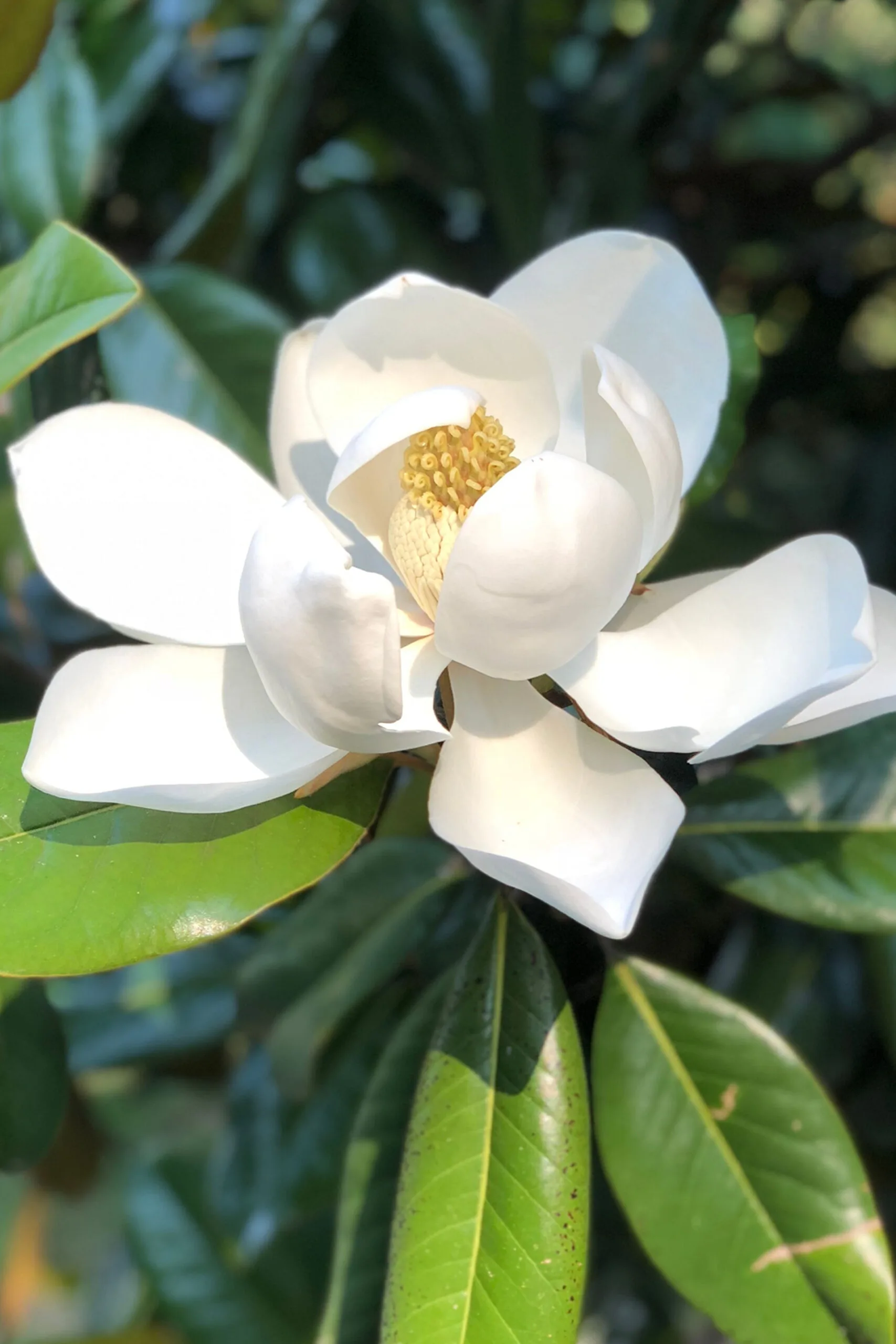
How to grow magnolias
Here’s how to take care of your manolia trees.
Water
Young magnolias need plenty of water, but once established and deeply rooted (their root system can span four times the overhead canopy!) they’ll tolerate short dry spells. If watering is needed, soak slowly so water sinks deeply into the soil. Do this fortnightly until regular rain returns.
Fertiliser
If soil is deep, dark and rich in organic matter, feeding isn’t necessary. However, spraying the leaves of young plants with soluble fertiliser helps them establish. Spray fortnightly from the time flowering ends until autumn and repeat the following year. When the plants are established, use a controlled-release fertiliser for trees and shrubs. Apply immediately after flowering finishes, topped with a compost mulch.
Pruning
In general, pruning isn’t necessary, but you can always remove dead or damaged branches and prune out others to encourage a more desirable shape. Prune deciduous magnolias straight after flowering, cutting back to the raised ‘collar’ found at the base of larger branches. Be careful not to cut past this collar, as this will discourage further flowering and growth.
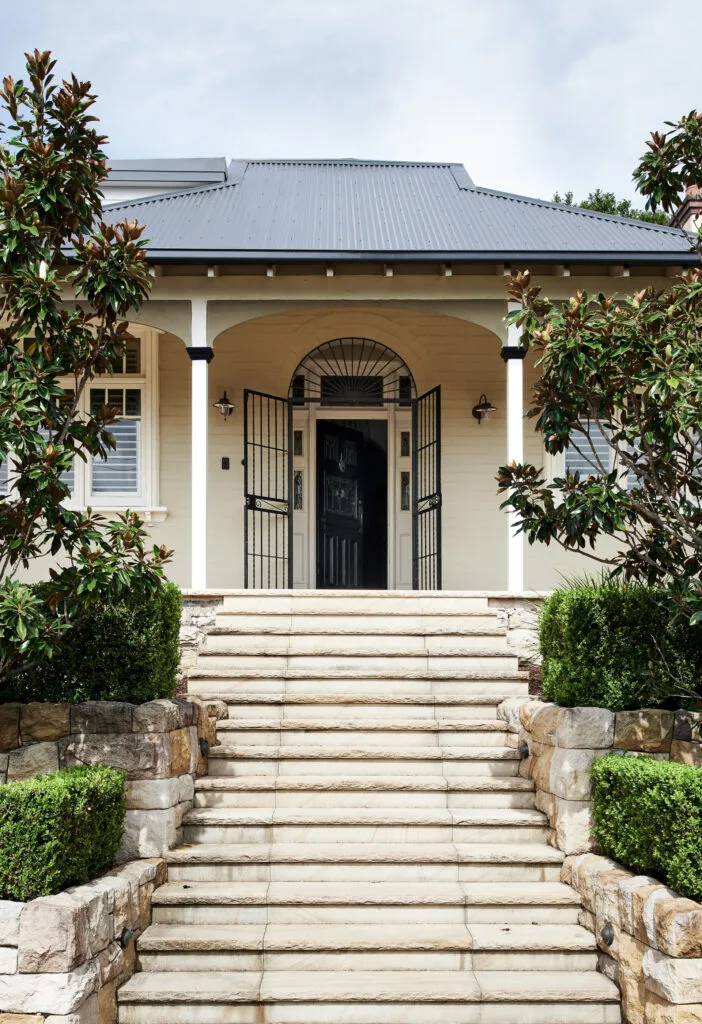
What are the disadvantages of a magnolia tree?
Beyond the obvious factors, such as ensuring enough space for your magnolia’s height, here are some additional details to consider
Shallow roots
- Magnolia trees have shallow root systems that can be damaged by strong winds or nearby construction.
- The roots of some magnolia varieties, like the Teddy Bear magnolia, grow horizontally, which can cause problems if the tree is planted too close to a building.
Disease
- Magnolia trees can be susceptible to powdery mildew, a disease caused by the fungus Microsphaera penicillata or Phyllactinia corylea.
Drought
- Summer heat and drought can cause leaves to develop brown edges in late summer.
- Magnolias need to be watered during dry weather, but too much water around the roots can be harmful.
Frost
- Some magnolia types are sensitive to frost and should not be planted in areas with frequent frost.
Messy leaves and flowers
- Evergreen magnolias drop large, glossy leaves year-round.
- Deciduous magnolias shed both leaves and flowers in autmn.
Other considerations
- Magnolias prefer some space to spread, so avoid planting them too close to structures.
- Magnolia trees should not be planted in areas with poor drainage or compacted soils.
